MERS Research
The Multicale Energy Resource Simulation (MERS) research group focuses on the multiscale numerical and experimental studies of the coupled physical processes in energy resources. Our specific research areas include:
1. Modeling of fractured (and faulted) rocks,
2. Molecular and experimental studies of hydrate-based methane, hydrogen, and CO2 storage,
3. Physics-informed graph neural networks for spatiotemporal modeling,
4. Advanced visualization with Mixed Reality (MR),
5. Numerical and Experimental thermo-hydro-chemo-mechanical (THCM) studies of underground CO2 and hydrogen storage,
6. Numerical and Experimental THCM studies of geologic hydrogen production and Enhanced geothermal systems (EGS).
Our research efforts in these areas are summarized below:
Modeling of Fractured Rocks
Fractured tight rocks, such as unconventional oil and gas (UOG) reservoirs and enhanced geothermal systems(EGS), have contributed to the increased interest in fracture modeling. Furthermore, many conventional rocks considered as candidates for underground CO2 and hydrogen gas storage are known to contain faults either within the domain or on its boundaries. So, it is important to consider the potential transport and leakage of these gases through these faults. The standard approach of using fault multipliers across the faces of these faults accounts for flow "across" or perpendicular to the faults but not "along" or parallel to its surface. We have made significant contributions to modeling fractures and faults accurately and efficiently, including:
- The development of an open-source "shale" module for the compositional simulation of fluid flow in fractured tight rocks. It is distributed as part of the MATLAB Reservoir Simulation Toolkit (MRST) and we wrote Chapter 10 of the Advanced MRST Book published by the Cambridge University Press in 2021.
- The development of the first 3D projection-based embedded discrete fracture model (pEDFM), which can model fractures of any orientation in a 3D space, as in the figures below (https://doi.org/10.2118/201243-PA).
- The development of a transient embedded discrete fracture model (tEDFM) for tight rocks, which replaces the pseudo-steady state matrix-fracture non-neighboring flux term in the EDFM with a transient term (https://doi.org/10.1038/s41598-022-26536-w).
- The development of a 3D continuous projection-based embedded discrete fracture model (CPEDFM), which fixes the limitation of pEDFM when sealing fractures are slanted (https://doi.org/10.2118/217469-PA).
- The coupling of pEDFM with the extended finite element method (XFEM) to model the propagation of hydraulic fractures in a naturally fractured reservoir (https://doi.org/10.1016/j.petrol.2022.110468).

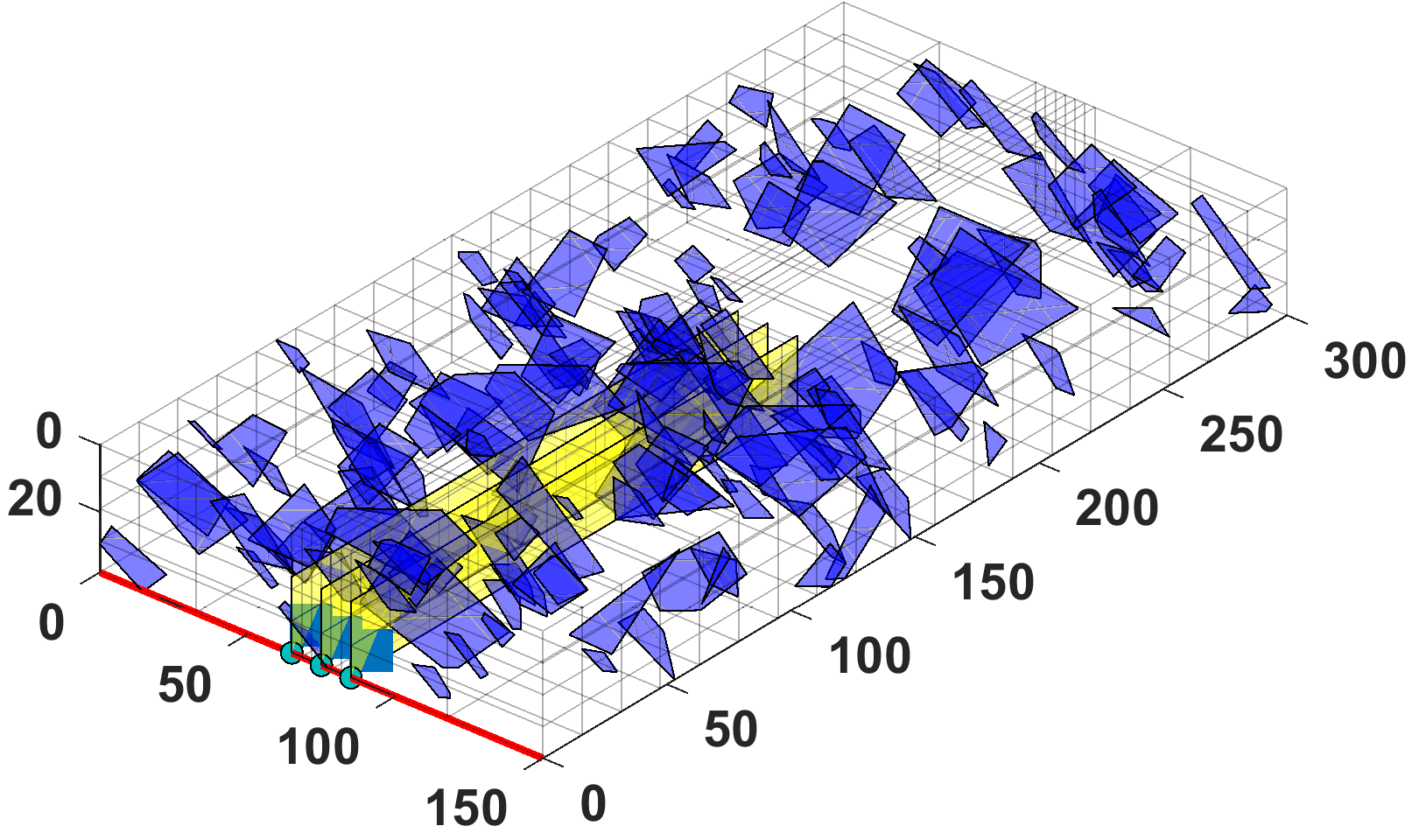
Molecular Simulation of Clathrate Hydrates
Gas clathrate hydrates are icelike crystalline solids that contain gas molecules caged within the ringed frameworks formed by hydrogen bonds in water molecules. They are formed when water and certain gases co-exist at high pressures and low temperatures. Hydrates vary in structure depending on the pressure, temperature, and size of the gas molecule. Various researchers have performed equilibrium MD simulations of gas hydrates to study how they form and dissociate. To account for the long-range electrostatic interactions in water, most of these studies use all-atom models (AAM) like the TIP4P-ice. However, non-polar gas molecules are modeled using united-atom models (UAM) for improved computational efficiency, like the optimized potential for liquid simulation (OPLS) for methane. The combination of all-atom and united-atom models still limits the scale of such MD studies to a couple of nanometers and nano- to microseconds because there are usually more than five water molecules to every gas molecule in a hydrate. Therefore, most previous studies that use all-atom water models to study hydrate formation are limited to very few hydrate cages and may not yield statistically significant results on the kinetics of hydrate formation/dissociation. We have performed coarse-grained MD studies using a 96x12x12 nm system with half-million molecules to obtain new insights into the formation and dissociation of gas hydrates.
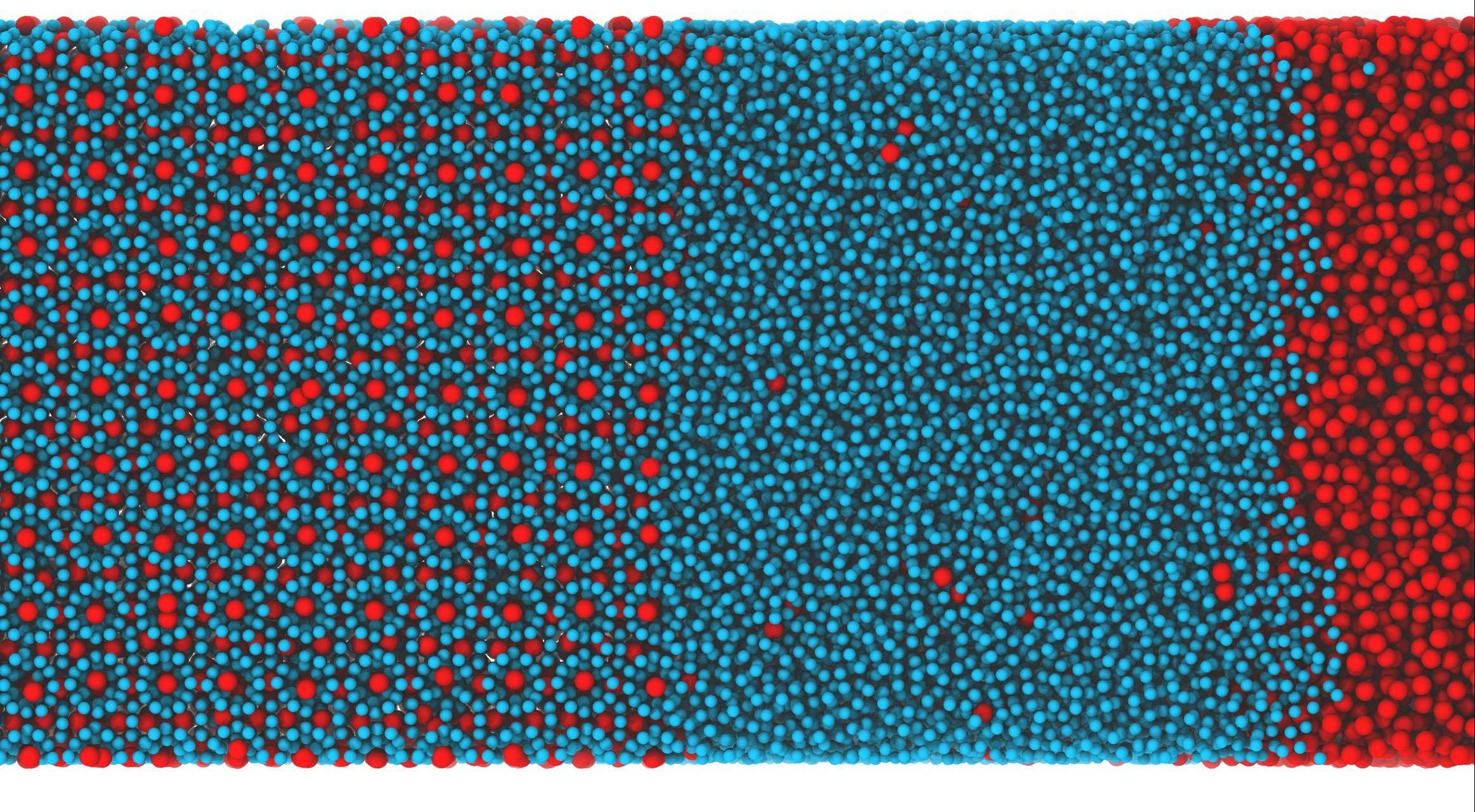
The video of the hydrate dissociation shown in the image above can be found here: https://youtu.be/AjxsjDPGF44.
Novel Slot-Drill Technology for Shale EOR
We have a pending patent on a novel shale enhanced oil recovery (EOR) technology that can triple the profit from unconventional oil reservoirs by continuously injecting gas and producing oil through mechanically cut horizontal fractures. According to the US Energy Information Administration (EIA), the US produced 2.67 billion barrels of oil from shale-oil reservoirs in 2020. This accounted for 65% of the total US oil production that year and is equivalent to an annual revenue of $160 billion, even at an oil price of $60 per barrel. However, shale-oil wells are reported to decline by 75-90% within the first three years of production, producing only 5-9% of the amount of oil initially in the reservoir. This has resulted in the growing application of cyclic gas EOR (CGEOR) to increase the amount of oil recovered from shale-oil reservoirs. Although CGEOR is the only EOR technology that has been demonstrated to work in these unconventional resources, it only increases the amount of oil produced by a factor of up to 1.7 in the best cases (like the Eagle Ford). It shows little to no increase in oil production from tighter and more naturally fractured shale plays like the Bakken.
Considering the worth of the shale EOR market and that the amount of oil left in the subsurface after applying the CGEOR method is more than 80% of the amount of oil initially in place (OIIP), any cost-effective technology that drastically increases the amount of oil produced from shale-oil reservoirs is expected to be a game-changer. We proposed using mechanically cut fractures at the top and bottom of the reservoir while injecting gas (at the top) and producing oil (at the bottom) continuously. As illustrated in the figure below, gas is injected through the red well and horizontal fracture at the top, while oil is produced from the horizontal fracture and green well at the bottom of the reservoir. Based on our numerical simulations, this technology can yield an increment factor or improved oil recovery (IOR) ratio of 3, even in the Bakken shale.
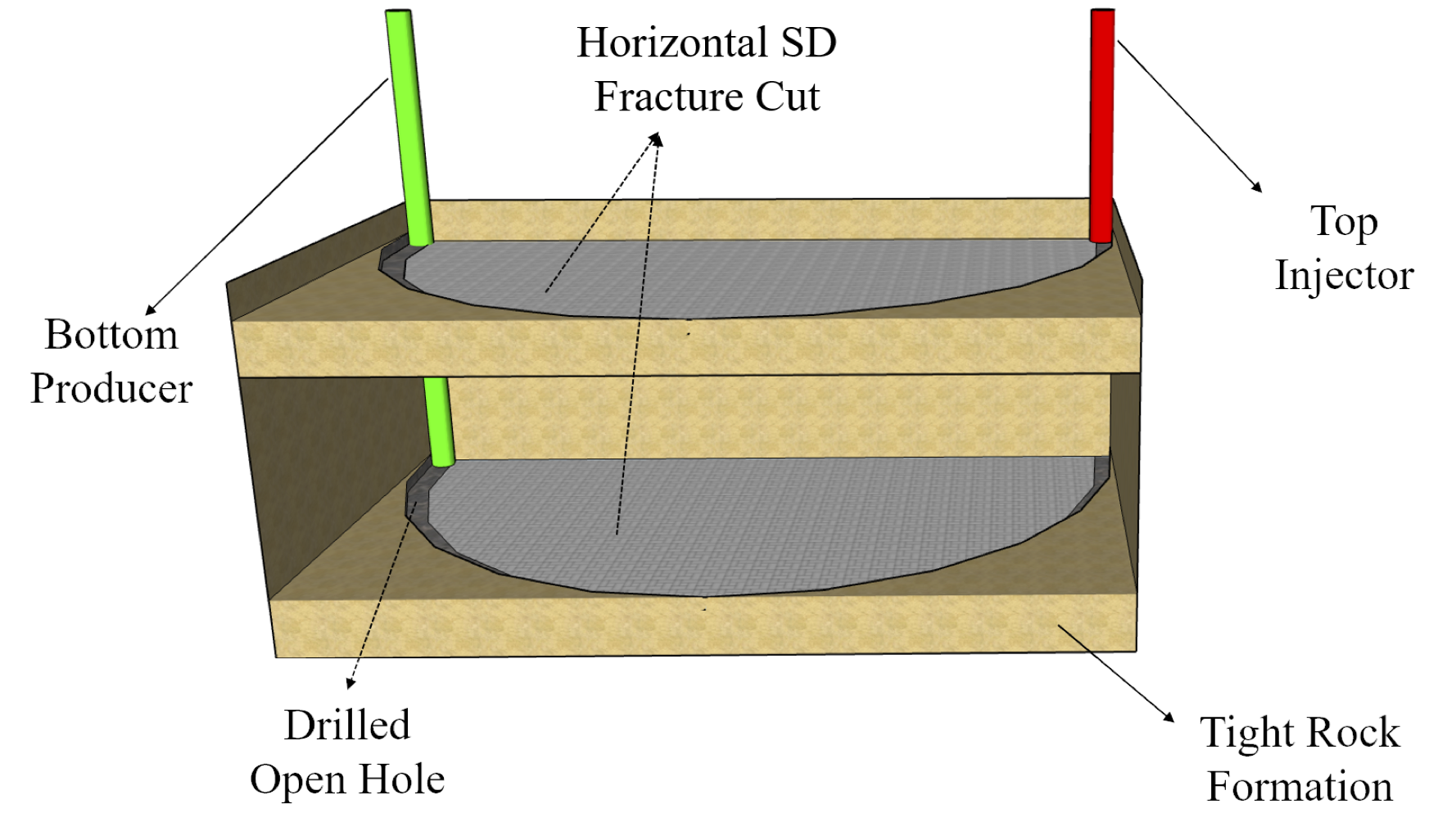
Figure illustrates the proposed Slot-drill EOR technology.
The rigorous numerical simulation studies of CGEOR and the proposed technology were published in SPE Journal (https://doi.org/10.2118/209597-PA). The results (below) show that the CGEOR is limited because the gas saturation and relative permeability near the fractures increase with each huff-and-puff cycle, significantly reducing the effective oil permeability and flow rate. The proposed technology significantly outperforms CGEOR because it involves continuous gas injection while producing oil from a different fracture.
We look forward to collaborations and funding to develop an experimental proof-of-concept that validates the game-changing recoveries predicted for the SDEOR technology.

Figure illustrates how the injected methane gas displaces the oil downwards (left) in an unfractured and (right) in a naturally fractured tight rock.

Figure illustrates the increased gas volume near the fracture surface in CGEOR.
Novel Slot-Drill Technology for Geothermal Reservoirs
We have another pending patent for applying the slot-drill technology to recover thermal energy from enhanced geothermal systems (EGS). Two of the proposed configurations of these slot-drilled fractures are shown below. The first is referred to as a triplet configuration because it involves three wells (in a pattern), whereas the other is referred to as a doublet because it involves only two wells. The control over the location and geometry of the fractures allows us to avoid the well-known problem of short-circuiting, which hydraulic fractures are vulnerable to. Additionally, the proposed technology avoids the problem of the low likelihood of intersecting all perfect planar fractures with two horizontal wells in virtually all simulations of thermal recovery from EGS with multistage fractured horizontal wells (MFHW).

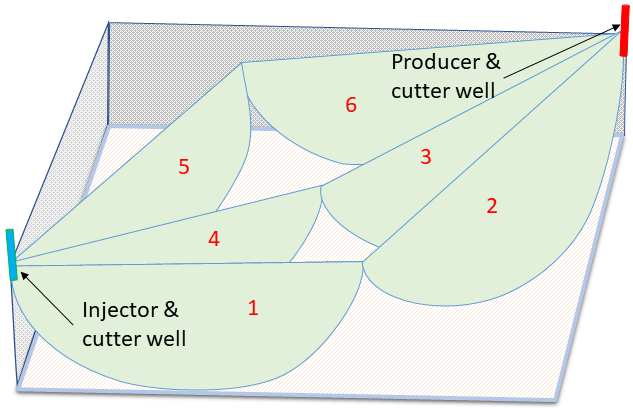
Figure shows (left) the triplet and (right) the doublet slot-drill configurations for efficient thermal recovery.
The figure below presents the simulated temperature profile obtained from the simulation of the proposed triplet and doublet configurations of slot-drill fractures.


Figure shows the temperature profile after 50 years of simulated thermal recovery from the (left) triplet and (right) doublet configurations.
We can use more than six slot-drill fractures to obtain higher thermal recoveries from the doublet configuration. In the results below, we used fourteen slot-drill fractures of the same total fracture surface area as an MFHW with nine planar fractures.

Figure shows that the proposed technology yields two times the thermal recovery from MFHW with the same fracture area.
This work is currently under journal review for publication, and we are currently performing experimental studies using the AutoLab equipment discussed in the next section. We are looking forward to collaborations on commercializing this technology.
Numerical and Experimental Studies of Coupled THM Processes in Fractured Rocks
Several researchers have performed numerical simulation studies of coupled thermal, hydraulics, and mechanical (THM) processes because of the importance of safely developing subsurface energy systems. Other authors have also published the results from their experimental investigations of THM processes. To address the question of the validity of numerical simulation results, a few researchers compare their simulation results against published experimental results in the literature. However, several necessary conditions of these experimental studies are typically not fully understood by the users of these results, leading to misleading assumptions in the boundary conditions of the simulation models. Conversely, a purely experimental study of THM processes is often fraught with the problem of scale and applicability to other subsurface rocks or scenarios that have yet to be studied explicitly. To address these gaps in the study of THM processes, we developed a high-resolution numerical simulation model that represents a coupled THM experimental setup.
We performed fully dimensional numerical studies of THM processes in tight rocks with stochastic fractures in 3D. The simulation model was calibrated to the high-frequency data from the AutoLab 1500 (shown below), which is a computer-controlled servo-hydraulic triaxial rock testing apparatus that can measure the effective permeability, pore-volume compaction, Young’s modulus, Poisson’s ratio, P-wave and S-wave velocities, acoustic emissions, and stress/strain relationships via strain gages and linear variable differential transducers (LVDT). The equipment was used to subject some core plugs to confining and axial stresses up to 10,000 psi at temperatures up to 150oC while flowing water through the core. The performance of these studies at high pressures, temperatures, and stresses makes the results representative of subsurface conditions in fractured tight rocks such as enhanced geothermal systems (EGS) and unconventional oil and gas (UOG) reservoirs. The quantification of the mechanical deformation of these rocks in response to pressure and temperature changes during production is essential for the safe development of these tight rocks.
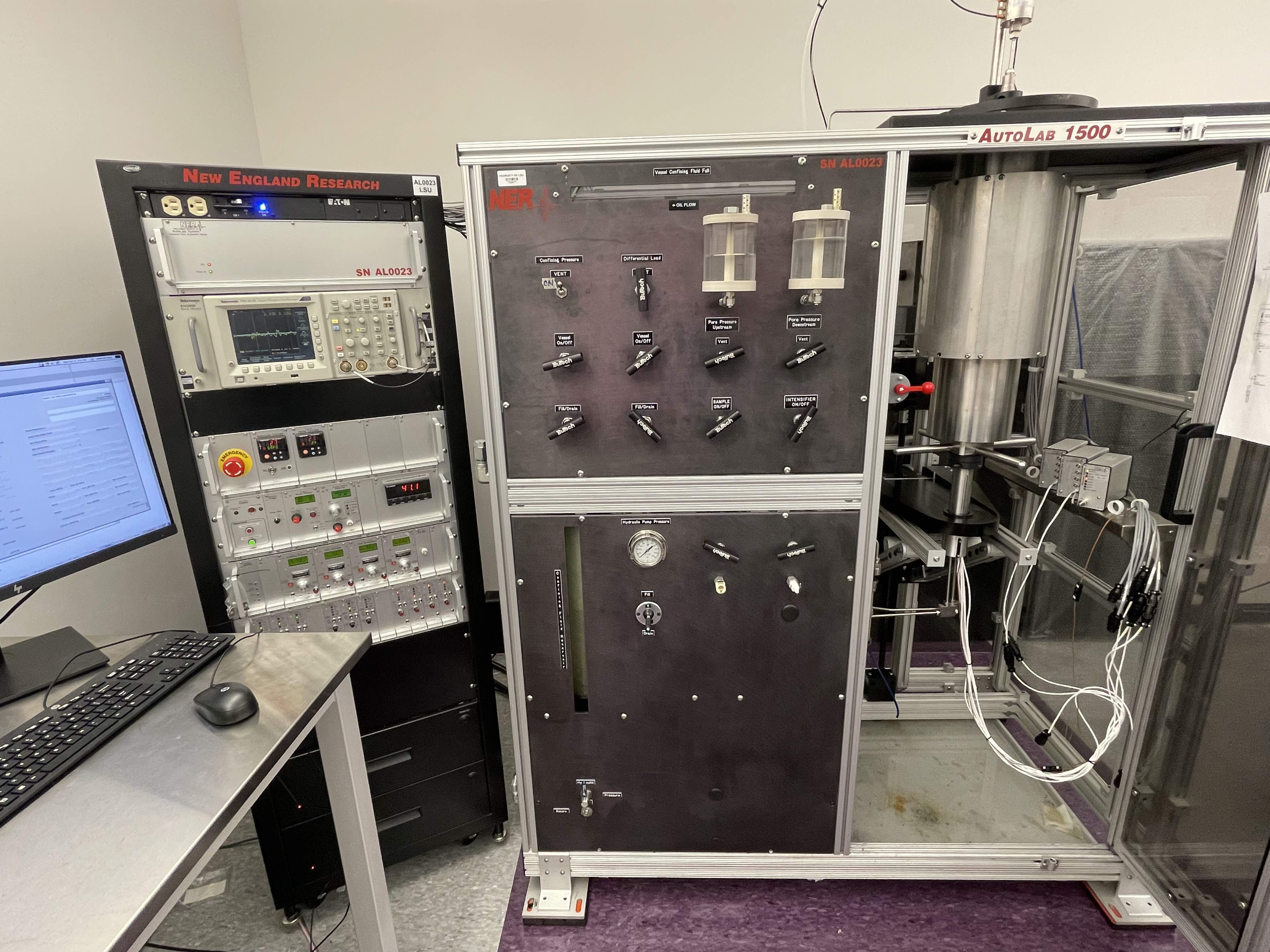
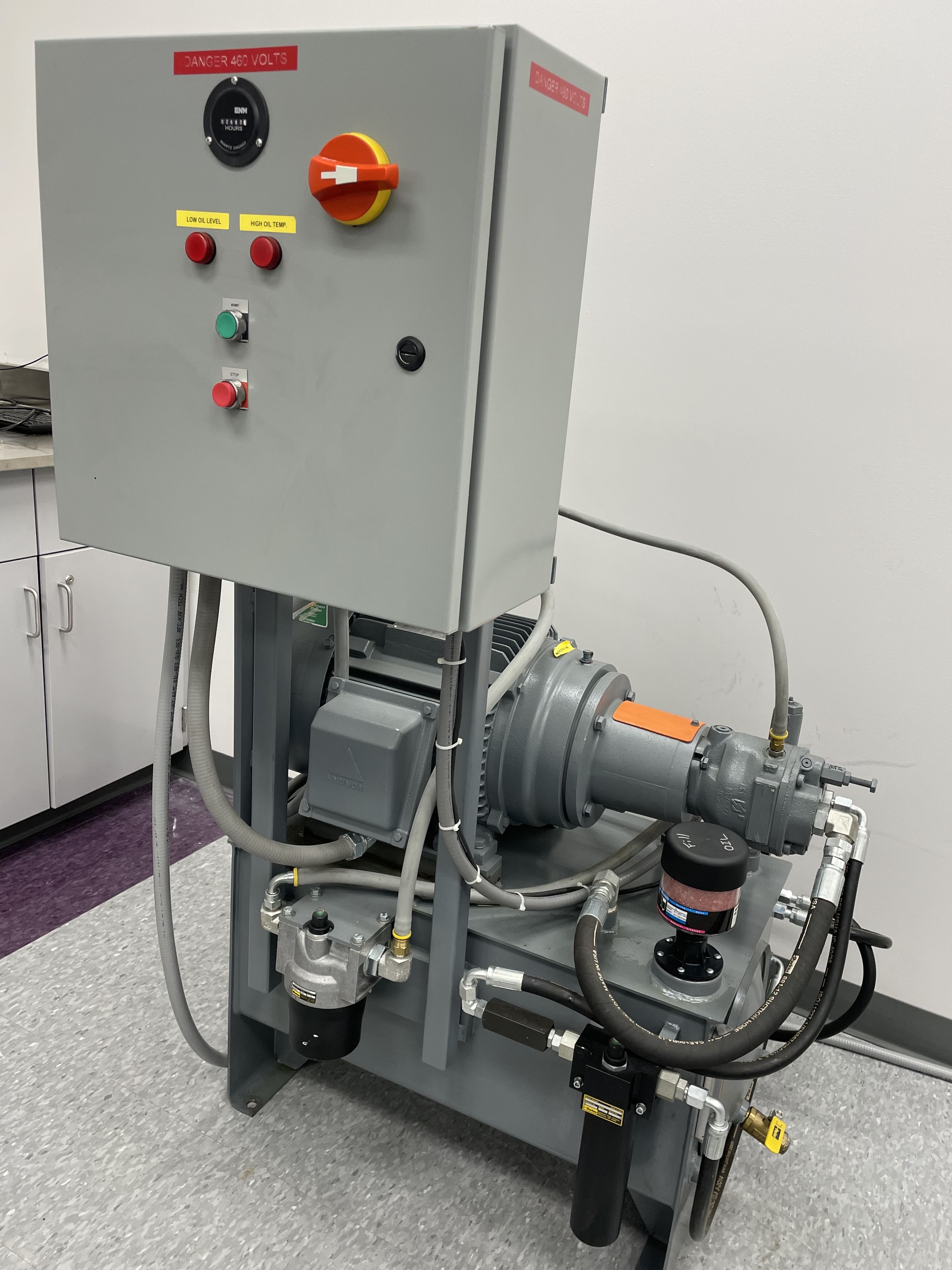
Figure shows (left) the AutoLab 1500 rock testing apparatus for the THM experiments and (right) its hydraulic pump.
In addition to the capability of performing these coupled THM experiments using AutoLab 1500, we have a liquid pressure pulse decay (PDPL) permeameter, which can measure liquid permeability under confining pressures. It can also be used to perform standard core-flooding experiments. It is shown below. Please get in touch with us (folorode@lsu.edu) for potential collaborations on any related experiments.
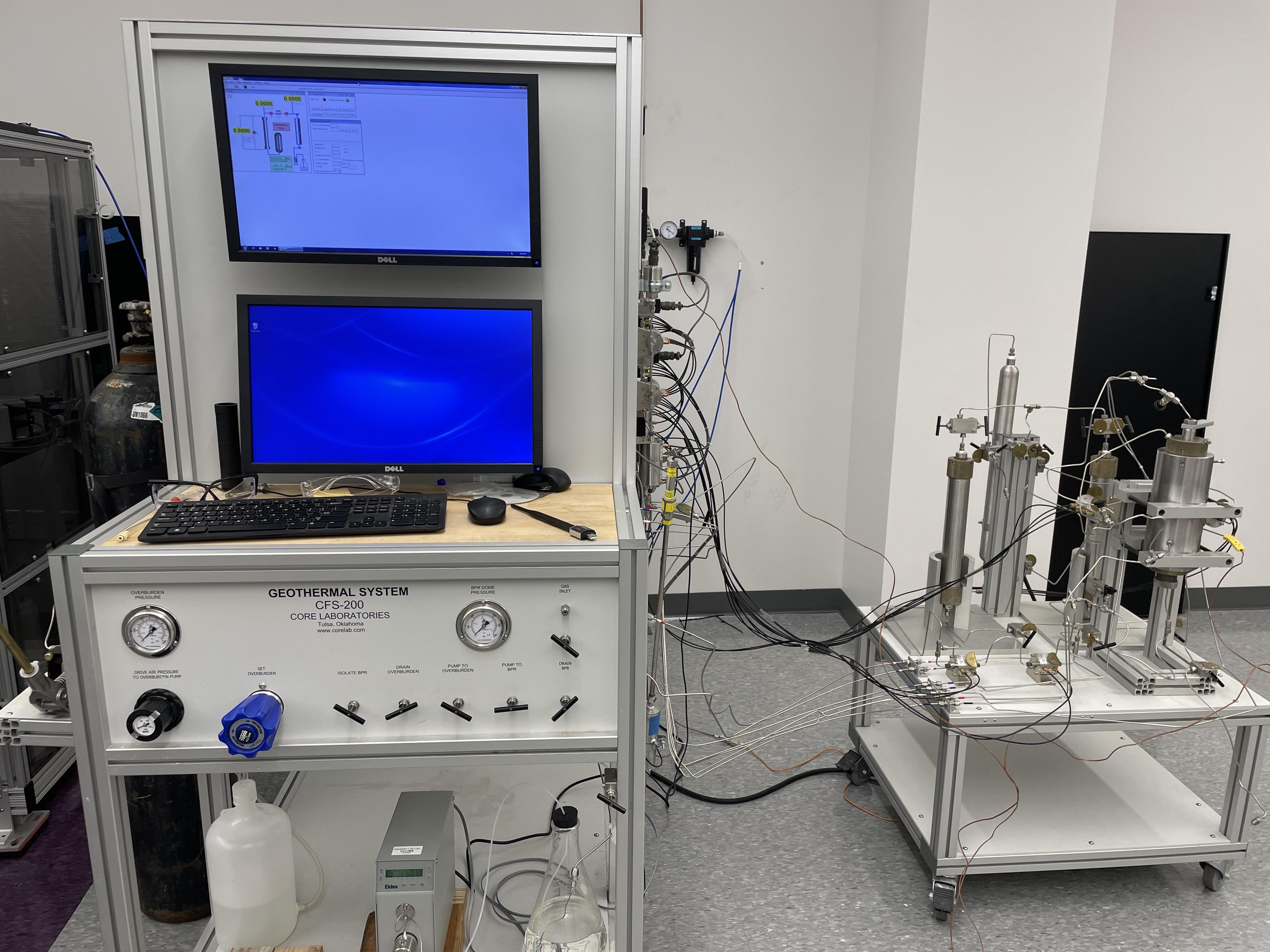
PDPL Permeameter
Recent Journals:
- Adeyemi, T* and Olorode, O. M.**, 2025. “Molecular Studies and Advanced Visualization of the Trapping of Methane Nanobubbles During Hydrate Growth”. Journal of Physical Chemistry B, Volume 129, Issue 15 (https://doi.org/10.1021/acs.jpcb.4c07851).
- Adibifard, M.* and Olorode, O. M.**, 2025. “Coarse-Grained Molecular Studies Reveal Potential for Increased CO2 Storage in Hydrates”. Materials Today Sustainability Journal, Volume 30 (https://doi.org/10.1016/j.mtsust.2025.101106).
- Olorode, O. M.**, Kolawole, O., Igweonu, C. S.*, Rashid, H. U.*, 2025. “Taking bio-induced precipitation to the field for sustainable geo-energy storage: Experimental and numerical studies of leakage mitigation”. Journal of Energy Storage, Volume 112 (https://doi.org/10.1016/j.est.2025.115474).
- Onwumelu, C., Kolawole, O., Nordeng, S., and Olorode, O. M., 2024. “Assessing the Effect of Thermal Maturation on Shale Organic Matter via PeakForce Quantitative Nanomechanical Mapping”. Rock Mechanics Bulletin (https://doi.org/10.1016/j.rockmb.2024.100128).
- Zhou, B., Chen, Z., Song, Z., Tang, Z., Wang, B., and Olorode, O. M., 2024. “A New Numerical Well-Test Model for Naturally Fractured Reservoirs Using an Analytically Modified Embedded Discrete Fracture Model”. Journal of Hydrology (https://doi.org/10.1016/j.jhydrol.2024.131330).
- Ngoma, M., Kolawole, O., and Olorode, O. M., 2024. “Geothermo-Mechanical Alterations Due to Heat Energy Extraction in Enhanced Geothermal Systems: Overview and Prospective Directions”. Deep Underground Science and Engineering Journal (https://doi.org/10.1002/dug2.12109).
- Rashid, H* and Olorode, O. M.**, 2024. “Use of controlled fractures in enhanced geothermal systems”. Advances in Geo-Energy Research Journal, Volume 12, Issue 1 (https://doi.org/10.46690/ager.2024.04.04).
- Rashid, H* and Olorode, O. M.**, 2024. “A Continuous Projection-based EDFM Model for Flow in Fractured Reservoirs”. SPE Journal, Volume 29, Issue 1 (https://doi.org/10.2118/217469-PA).
- M. Adibifard* and O. M. Olorode**, 2023. “Large-Scale Nonequilibrium Molecular Studies of Thermal Hydrate Dissociation”. Journal of Physical Chemistry B, Volume 127, Issue 29, 6543–6550 (https://doi.org/10.1021/acs.jpcb.3c03391).
- U. Egbe, O. Awoleke, O. M. Olorode**, Scott Goddard, 2023. “On the Application of Probabilistic Decline Curve Analysis to Unconventional Reservoirs”. SPE Reservoir Evaluation & Engineering 26 (02), 244-260 (https://doi.org/10.2118/212837-PA).
- O. M. Olorode** and H. Rashid*, 2022. “Analytical Modification of EDFM for Transient Flow in Tight Rocks”. Scientific Reports 12 (1), 22018 (https://doi.org/10.1038/s41598-022-26536-w).
- H. Rashid* and O. M. Olorode**, 2022. “An iteratively coupled model for flow, deformation, and fracture propagation in fractured unconventional reservoirs.” Journal of Petroleum Science and Engineering, Volume 214, July 2022, 110468 (https://doi.org/10.1016/j.petrol.2022.110468).
- H. Amer* and O. M. Olorode**, 2022. “Numerical Evaluation of a Novel Slot-Drill EOR Technology for Tight Rocks”. SPE Journal, Volume 27, Issue 04 2294-2317 (https://doi.org/10.2118/209597-PA).
- T. Ihunde* and O. M. Olorode**, 2022. “Application of physics informed neural networks to compositional modeling.” Journal of Petroleum Science and Engineering, Volume 211, April 2022, 110175 (https://doi.org/10.1016/j.petrol.2022.110175).
- B. Yang+, H. Wang, Z. Shen, O. M. Olorode, B. Wang, Y. Zheng, W. Yan, and Z. Jia, 2021. “Full-Sample X-ray Microcomputed Tomography Analysis of Supercritical CO2 Fracturing in Tight Sandstone: Effect of Stress on Fracture Dynamics”. Energy Fuels Journal, 2021, Volume 35, Issue 02, 1308–1321 (https://doi.org/10.1021/acs.energyfuels.0c03554).
- O. M. Olorode**, B. Wang, H. U. Rashid*, 2020. “Three-Dimensional Projection-Based Embedded Discrete Fracture Model for Compositional Simulation of Fractured Reservoirs”. SPE Journal, 2020, Volume 25, Issue 04, 2143–2161 (https://doi.org/10.2118/201243-PA).
- O. M. Olorode**, I. Y. Akkutlu, Y. Efendiev, 2017. “Compositional reservoir-flow simulation for organic-rich gas shale”. SPE Journal, 2017, Volume 22, Issue 06, 1963-1983 (https://doi.org/10.2118/182667-PA).
- T. O. Odunowo, G. J. Moridis, T. A. Blasingame, O. M. Olorode, C. M. Freeman, 2014. “Evaluation of Well Performance for the Slot-Drill Completion in Low- and Ultralow-Permeability Oil and Gas Reservoirs”. SPE Journal, 2014, Volume 19, Issue 05, 748–760 (https://doi.org/10.2118/164547-PA).
- O. M. Olorode**, C. M. Freeman, G. J. Moridis, T. A. Blasingame, 2013. “High-resolution numerical modeling of complex and irregular fracture patterns in shale-gas reservoirs and tight gas reservoirs”. SPE Reservoir Evaluation & Engineering Journal, 2013, Volume 16, Issue 04, 443-455 (https://doi.org/10.2118/152482-PA).